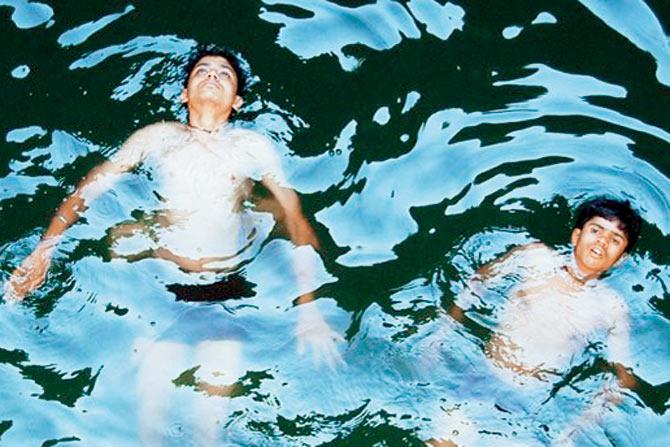Do you enjoy seeing some movies twice or more often? I guess that’s a rhetoric question in a country where films — okay, Dilwale Dulhaniya Le Jayenge — have been running for 20 years.

 Do you enjoy seeing some movies twice or more often? I guess that’s a rhetoric question in a country where films — okay, Dilwale Dulhaniya Le Jayenge — have been running for 20 years. And it’s quite normal to find people watching that film for the 42nd time saying “Ah, the film’s a good manual on how to patao your future father-in-law.” Repeat viewing is the backbone of a solid hit, I suppose.
Do you enjoy seeing some movies twice or more often? I guess that’s a rhetoric question in a country where films — okay, Dilwale Dulhaniya Le Jayenge — have been running for 20 years. And it’s quite normal to find people watching that film for the 42nd time saying “Ah, the film’s a good manual on how to patao your future father-in-law.” Repeat viewing is the backbone of a solid hit, I suppose.
For films I love, it’s a real pleasure seeing them a second time. I was told that for the remarkable Tamil film Paruthiveeran, a feisty and fierce Romeo-and-Juliet tragedy set in Madurai, the climax is so horrific, that for the many months the film ran in theatres, the entire audience would leave the hall before the last 20 minutes, unable to handle the fate of the heroine. But they would come right back for the next show.
ADVERTISEMENT

A still from the 2010 Marathi film Vihir (The Well), directed by Umesh Vinayak Kulkarni
More recently, I watched Masaan first at a press preview, and again, when I took my nephew, a Carnegie Mellon University student, to watch it when he was on a Mumbai visit. It was even more delicious the second time round. You often notice little details, or make connections, that you missed the first time, or you savour them more, as they are spiced with anticipation. For instance, Neeraj Ghaywan decides to set the scene in which the protagonists discover the magic of love, during Durga Puja celebrations, with a top shot of entire streets jauntily lit up with “running lights”. There’s even a magic show, literally enhancing the mood and intoxication of first love, before he sends that red balloon soaring into the night sky. When that magnificent shot of the Ganga ghats in the foreground, and the train in the far horizon, was on screen, and the song, Tu kisi railsi guzarti hai, main kisi pull-sa thartharata hoon played a second time round, I wondered how much of it was Avinash Arun’s brilliant cinematography, and how much was CGI.
The last few weeks have been a season of second passes, since as India Mentor for Jio Mami Young Critics’ Lab of the Mumbai Film Festival, I shared some of my favourite regional language movies with the students. One of these was Umesh Kulkarni’s Vihir, a rich, philosophical film about a teenager grappling with the death of his beloved cousin, written by the gifted Girish Kulkarni and Sati Bhave. While Samir is melancholic about his cousin Nachiket’s death, his mother has returned to her routine. There’s a small, throwaway scene, as she delightfully tittups, pulling down the hem of her sari with her heels, all the while giggling and gossiping on the phone, that delighted me so much this time. The wonderful idea of Samir distributing mithai after the late Nachiket’s exam results are out, and he's done well! There’s Girish Kulkarni’s character himself — an uncle who is probably “useless” in terms of earning an income, but is a true rasik of Hindustani classical music, and cooks a mean chicken curry. These are telling details that would rarely find space in a review.
In Rajeev Ravi’s Annayam Rasoolum (Anna and Rasool; Malayalam), another love tragedy, I was even more convinced that although he has a compelling story to tell — including pertinent comments about how India suffocates ordinary Muslims who only want to make an honest living — the film was much more about atmosphere, texture and music. In fact, the heroine has barely five lines of dialogue in the entire film. It is uncanny, how this film seems to connect with Wong Kar Wai’s In the Mood for Love, another love tragedy, that conveys ache and longing, not so much through dialogue but through music, texture and lighting. In music, you can evoke all kinds of feelings that may, on paper, sound illogical. The haunting song Quizas, quizas, quizas (Perhaps, perhaps, perhaps), that plays as a refrain through In the Mood for Love, is a Spanish song, sung by Nat King Cole, used to such terrific effect in a Hong Kong film, made in Cantonese. Truly, some of the greatest moments in cinema are without words.
Meenakshi Shedde is South Asia Consultant to the Berlin Film Festival, award-winning critic, curator to festivals worldwide and journalist. Reach her at meenakshishedde@gmail.com.
The views expressed in these columns are the individual’s and don’t represent those of the paper.
 Subscribe today by clicking the link and stay updated with the latest news!" Click here!
Subscribe today by clicking the link and stay updated with the latest news!" Click here!







